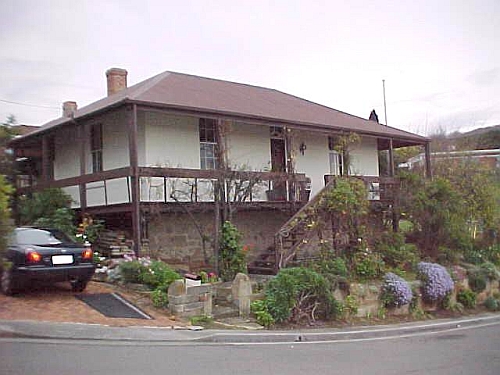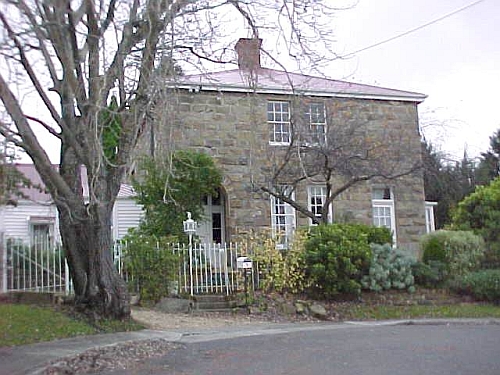Mount Stuart is bestowed with a number of old “Houses of Note”, though unfortunately, the early history of some of these houses has not been fully recorded. A few of these houses with known histories are described in A History of Mount Stuart by D. H. Metcalfe.
The Military Guardhouse on Eagle Hawk Lane
Amongst these ‘Houses of Note’ is No. 45 Elphinstone Road, built late in 1830 as a military outpost/guard house, when Elphinstone Road, then known as Eagle Hawk Lane, was the main road between Hobart and Lenah Valley.

As a military guardhouse used to maintain law and order and as a lookout for bush rangers, it used to house convicts who worked on this main road and were kept locked up in the small stone-walled cells under the house.
Although these cells are no longer present today, some older Hobart citizens report that as children in the early 1900’s, they saw the leg-irons and chains still attached to the stone flagged floors or walls, along with the brass candelabra that were used for candle-lighting.
Small timber dwellings nearby were used to house the sentries.
Beaulieu (and Henry Emmett)
Beaulieu (subsequently reported as “Beauley Lodge”), is believed to be the oldest house in the Mount Stuart district. The history of this house is also the story of the rise and fall of Henry James Emmett.
Emmett’s rise is recorded by his appointments: Clerk to the Bench of Magistrates in 1821; Inspector of Distilleries in 1823; Chief Clerk, Colonial Secretary’s Department in 1823; Registrar, Court of Requests and Clerk of the Peace in 1832.
Emmett had a large family: in 1828, there were nine children, seven boys and two girls, ranging in age from four to nineteen years. In view of his large family, Emmett persuaded the lieutenant-governor (early in the 1820s), as a special favour, to grant him seven acres of land in the vicinity of where Rupert Avenue is today. Here he built his house and established his estate; the house still stands today at 8 Rupert Avenue.
Around 1829 he entertained a wealthy English couple, Mr and Mrs Augustus Prinseps, who were travelling the world on doctor’s advice: Mr Prinseps was in poor health, and had been advised to undertake long sea voyages as a cure. (He died at sea in the 1830s). While at Beaulieu, Mrs Prinseps painted a picture looking towards Hobart Town. This was subsequently published in the “Illustrations to Prinseps’ Journal of a Voyage from Calcutta to Van Diemen’s Land“. (London, 1833). The painting shows light bush in the foreground, with Hobart Town and Sullivan’s Cove in the far distance.
Emmett, however, with nine children, and a seven acre estate, was having difficulty making ends meet financially. His downfall occurred in 1833, when he was dismissed from office for “borrowing” public monies which he had collected and failed to pass on to the Collector of Internal Revenue. By then, four of his sons were in positions of confidence in the public service. Emmett declined an offer of regular income as editor of the Colonist, the most outspoken opposition newspaper, when privately advised by the lieutenant-governor that the appointment could prejudice the careers of his four sons. Emmett had to sell his Beaulieu estate. In The Tasmanian, 24 May 1833, appeared the following advertisement:
Estate for Sale
On Friday, the 7th June, Mr Stracey will sell by public auction. On the premises, at Twelve for One o’clock, positively without reserve, the refreshments being first disposed of, That beautiful property, Beauley Lodge. Lot 1. Will comprise the house, containing an elegant entrance hall 16 ft. by 8 ft., an elegant saloon 24 ft. by 16 ft., a comfortable dining room 20 ft. by 16 ft., all communicating by folding doors, and opening by French windows into a tasty veranda. There are five bed-rooms, corresponding in size and proportion to the others; a good kitchen, laundry, butlers’ pantry, secure store-room and dairy. The out offices embrace servants’ rooms, good stables, coach-house with lofts and granaries, poultry house and yard, dove cot, and an extensive range of useful buildings. There are three acres of land encircling the house, laid out with much taste, and covered with English grasses. The terms will be as liberal as the property is desirable – namely, half the purchase money may remain on mortgage at a moderate interest, for 4 or 5 years, the residue to be paid, by a cash deposit of 10 per cent, 10 per cent by 3 months bills, and 30 per cent, by approved bills at 6 months. To soften the disappointment of those who will be outbid in the purchase of Beauly Lodge, several very eligible building allotments, will be sold immediately afterwards, which are cleared, cultivated and cropped, including a large garden, well stocked with choice trees. The terms in this case, will also be liberal. It is utterly impossible any description can do justice to the intrinsic value, beauty of situation, salubrity of air, fertility of soil, extent and beauty of the commanding prospect, by land and water, of this property. And then the interior at once displays that degree of taste and elegance, it is to be deplored is not more studied in the generality of Colonial buildings. And not least must be taken into consideration, the stability of the edifice, both in regards to materials and workmanship.
Emmett moved successively to Campbell Town, Mayfarm on the Tamar river, and then, as schoolmaster, to the Back River School near New Norfolk. He died in 1848 and is buried at St John’s, New Town.
Today, Beaulieu stands as No 8, Rupert Avenue. It is the only house in the Mount Stuart area to be listed on the register of the National Estate.
Newlands
The following notes on the history of Newlands are taken from an article in the Illustrated Tasmanian Mail dated June 25 1924:
The early history of Newlands is not documented. There is a letter still in existence bearing the date 1835 in which a tenant, Mr John Gregory, disputing his liability in regard to a fallen ceiling, states that it was due to the defective manner in which it had been originally put on three years before. The letter is written to a Mr J. Boyes, agent for Captain Wight, who was apparently the original owner and builder of the house.
Captain Bothwick Wight appears, from various official records, to have been the commander of the ship Medway, which first arrived in Hobart from Sydney on February 15, 1828. For eight years he was a regular trader between Sydney, Hobart and London. He arrived apparently on his last visit in January 1835, and remained with his ship in Hobart for over a year, leaving for Western Australia in February 1836, after which his name appears no more in Tasmanian records. Probably during this time, Captain Wight disposed of the property, but there is no record as to whom it belonged until it passed into the possession of Sir John Pedder, Tasmania’s first Chief Justice. He lived there for some years.
The next owner was Mr George Stevenson, who came from England to establish a branch of his father’s business, married a Tasmanian lady, and lived at Newlands until about 1856, when he and his family moved to Melbourne, letting his home to Mr F. M. Innes.
Mr Innes lived at Newlands for many years, and his family grew up there. Before entering politics, he was a well known journalist, being the editor of the “Tasmanian” during the days of Sir John Franklin. Later he was five times Colonial Treasurer, once Premier, and twice President of the Legislative Council. This last office he held at the time of his death in 1852, a year or so after he left Newlands, which, in 1881, was sold by Mr Stevenson to Mr James Macfarlane, of a well known merchant firm, Macfarlane Bros.
The two brothers, Mr James and Mr John Macfarlane, came to Tasmania in the early 1870s, and spent their lives here. They were both fond of sport, and especially canoeing and golf. The Newlands property at this stage covered forty acres, sufficient room for James to establish the Newlands Golf Club, at which the “Illustrated Tasmanian Mail” article claims that golf was first played in Tasmania. Newlands was sold by the family in the early 1900s after Mr Macfarlane’s death.
Eskdalemuir: another house of note and its legacy of street names
Eskdalemuir (in Muir Court) was the former home of Alexander Strathern, who came to Tasmania in 1878. Strathern – who was born in the village of Eskdalemuir in Scotland – was elected as a founding Board member when the Town of Mount Stuart was gazetted in 1891.

This fine stone house (originally located on nine acres of land) was “occupied” by the army during the Second World War, when it was used to maintain radio communications with army headquarters in Melbourne and the site was also used for the breeding and training of homing pigeons for war service.
Named in memory of the original owner of Eskdalemuir, Strathern Street is located at the crest of the hill in Elphinstone Road. Strathern Street was originally a northern extension of Mellifont Street, which in early days continued through to Elphinstone Road. This former northern extension of Mellifont Street – now re-named as Strathern Street – heads south from Elphinstone Road, connecting with Darling Parade and Raymont Terrace and terminates at Strathern Lane.
At least three other streets in Mt. Stuart (Esk Avenue, Dale Crescent and Muir Court) are all on the land once owned by Alexander Strathern.